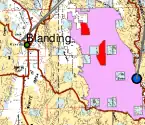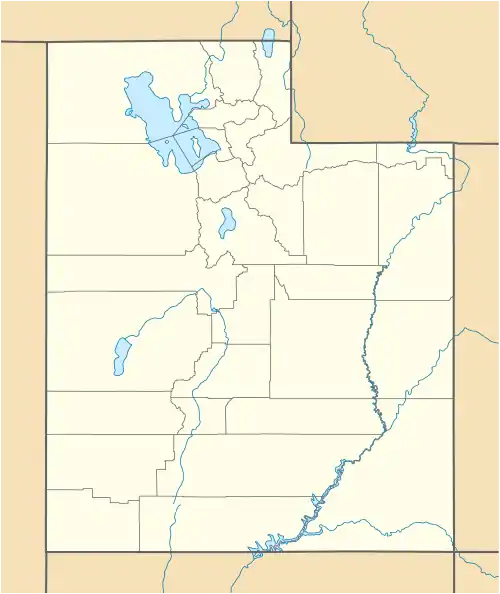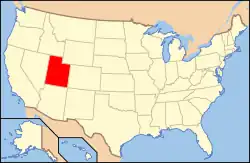Alkali Ridge | |
 Extract from a BLM map of eastern Utah; the National Historic Landmark is shown in red | |
  | |
| Location | San Juan County, Utah, USA |
|---|---|
| Nearest city | Blanding, Utah |
| Coordinates | 37°43′51″N 109°24′40″W / 37.7307°N 109.41099°W |
| Area | 2,340 acres (950 ha) |
| NRHP reference No. | 66000740 |
| Significant dates | |
| Added to NRHP | October 15, 1966[1] |
| Designated NHLD | July 19, 1964[2] |
Alkali Ridge, also known as Alkali Point, is a set of widely scattered archaeological remains of the earliest forms of Puebloan architecture, representing a period of transition from scattered, pit-style dwellings to a settled agricultural lifestyle.
Description
These multi-story buildings and kivas have yielded high-quality ceramics, and form the type location for the Pueblo II period (c. 900 CE – c. 1100 CE). The landmarked areas are noted for the density of archaeological materials, with an average density of 200 sites per square mile across the 2,340-acre (950 ha) area.[3] These resources provide an important view of the transitions of early inhabitants from pit houses to pueblos, because there are examples of all of the major forms between them. Its most important sites were first excavated in the 1930s.[4] It was declared a National Historic Landmark in 1964.[2]
Cacao residue was detected in Site 13 ceramics after testing by University of Pennsylvania and Bristol-Meyers Squibb researchers.[5]
"At Alkali Ridge there are faint marks of an ancient road, likely a trade route that connected this settlement to trading and cultural partners beyond."[6]
Bears Ears
The Bears Ears Inter-Tribal Coalition (BEITC), which was formed in 2015 with representatives from the Hopi, Navajo, Ute Mountain Ute, Pueblo of Zuni, and Ute Indian Tribes[7][8][9] submitted a report that led to the creation of Bears Ears National Monument which included Alkali Ridge as one of six "cultural special management areas" along with the Hole-in-the-Rock Historical Trail and the Grand Gulch, Big Westwater Ruin, Dance Hall Rock, Sand Island Petroglyph Panel, the Newspaper Rock Petroglyph Panel, and the Butler Wash Archaeological District National Register site.[9]: 2, 3
See also
References
- ↑ "National Register Information System". National Register of Historic Places. National Park Service. January 23, 2007.
- 1 2 "Alakali Ridge" (PDF). National Historic Landmark summary listing. National Park Service. Archived from the original on February 21, 2017. Retrieved May 26, 2017.
- ↑ "Draft Resource Management Plan for the San Juan Resource Area of the Moab District". Bureau of Land Management. 1986. Retrieved March 7, 2018.
- ↑ Morgan, William (2014). Ancient Architecture of the Southwest. University of Texas Press. pp. 5, 19. ISBN 9780292757677.
- ↑ Washburn, Dorothy K.; Washburn, William N.; Shipkova, Petia A. (2013). "Cacao consumption during the 8th century at Alkali Ridge, southeastern Utah". Journal of Archaeological Science. 40 (4): 2007–2013. doi:10.1016/j.jas.2012.12.017.
- ↑ Esperdy, Gabrielle; Kingsley, Karen, eds. (2012). "Alkali Ridge". SAH Archipedia. Charlottesville: University of Virginia Press. Society of Architectural Historians. Retrieved May 26, 2017.
- ↑ "The Public Lands Initiative is a Disaster for Utah's Wild Places". Southern Utah Wilderness Alliance (SUWA). Salt Lake City, Utah. 2016. Retrieved May 15, 2017.
- ↑ Bears Ears: A Native Perspective (PDF) (Report). Bears Ears Inter-tribal Coalition (BEITC). October 2015. p. 16. Retrieved May 16, 2017.
- 1 2 "Tribal Resolutions" (PDF) (Press release). Hopi Tribe, Navajo Nation, Ute Mountain Ute Tribe, Pueblo of Zuni, and Ute Indian Tribe. Retrieved May 6, 2016.
Further reading
- Brew, John Otis (1946). Archaeology of Alkali Ridge, Southeastern Utah. Cambridge: Harvard University Press.
- Lipe, William D.; Varien, Mark D. (2000), Spatial Patterning in Northern San Juan Villages, A.D. 1050–1300, Kiva, vol. 66, pp. 91–122
- Morgan, William N. (1994). Ancient Architecture of the Southwest. Austin: University of Texas Press.
External links
- BLM page on the Alkali Ridge area

